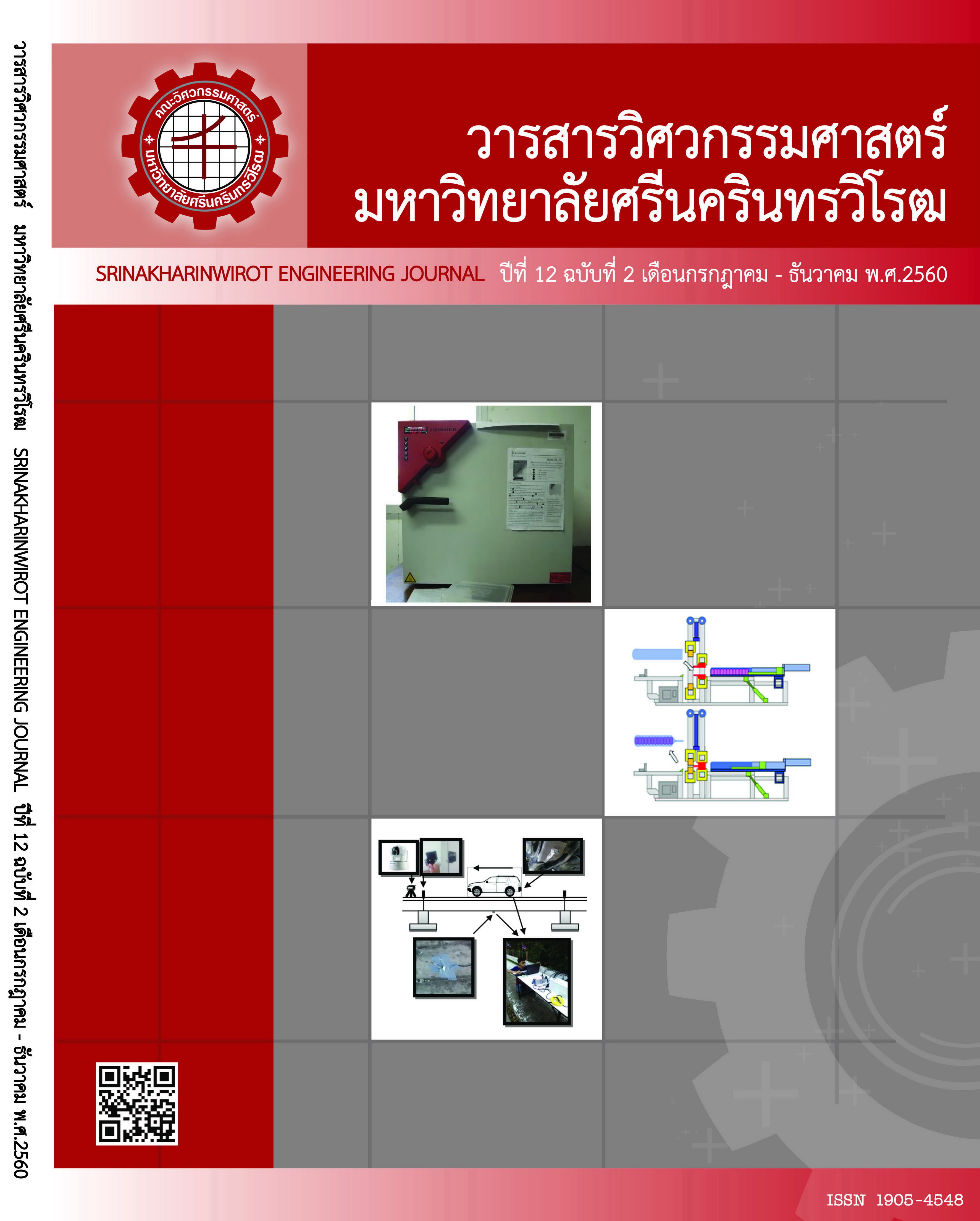Upper-limb Exoskeleton Robot with Rehabilitation Activities for Stroke Rehabilitation
Main Article Content
Abstract
The objective of this research was to develop an upper-limb exoskeleton robot with interfacing to rehabilitation activity games for hemiplegic stroke patients. The developed robot is CUREs. The CUREs robot is patenting under the author names with patent request no. 1601003553 [23]. It has four-degree-of-freedom. The robot arm has gravity compensation so that the smaller actuators can be used and the better performance of the dynamic control system can be achieved compared to the heavier arm that normally seen in the market. The detail of the development of robot arm and controller design can be consulted in [15], [18]. In this paper, the kinematics and the dynamic model of the robot arm will be analyzed in detail. Both are used for developing the interface between the robot arm and rehabilitation games or activities. The rehabilitation activities can improve recovery rate compare to normal treatment in hemiplegic stroke patients. The interface technique between the robot and rehabilitation game, developed in this paper, can be implemented not just only the in-house game but also to most of the commercial games. Actually, there are two types of rehabilitation activity games. One will cover the activities for specific treatments assigned by a physician or a physical therapist. The other is for relaxing after going through a period of specific training. The second type of training activity is based on available arcade games or commercial games and will help to improve arm movement control close to the normal arm movement. The force control, of the dynamic controller, of the robot arm can be adjusted force to suit to individual patients. The main benefit of the interfacing can help to extend to various type of rehabilitation activities.
Article Details
Copyright belongs to Srinakharinwirot University Engineering Journal
References
[2] P.S. Lum, C.G. Burgar, P.C. Shor, M. Majmundar, and M. van der Loos, “Robot-assisted movement training compared with conventional therapy techniques for the rehabilitation of upper limb motor function after stroke,” Arch. Phys. Med. Rehabil., vol. 83, pp.952-959, 2002.
[3] S.E. Fasoli, et al., “Effects of robotic therapy on motor impairment and recovery in chronic stroke”; Arch. Of Phys. Med. & Rehabil, vol.84, pp.477-482, 2003.
[4] R. Loureiro, F. Amirabdollahian, M. Topping, B. Driessen and W. Harwin, “Upper Limb Robot Mediated Stroke Therapy – GENTLE/s Approach” Special Issue on Rehabilitation Robotics Journal of Autonomous Robots, 2003.
[5] N.A. Bayona, J. Bitendky, K. Salter and R. Teasell, “The role of task-specific training in rehabilitation therapies,” Top. Stroke Rehabil, vol. 12, no. 3, pp. 58-68, summer 2005.
[6] P. Maciejasz, J. Eschweiler, K. Gerlach-Hahn, A. Jansen-Troy and S. Leonhardt, “A survey on robotic devices for upper limb rehabilitation.” Journal of Neuroengineering and Rehabilitation, 2014, 11:3.
[7] H.I. Krebs, J.J. Palazzolo, L. Dipietro, M. Ferraro, J. Krol, K. Rannekleiv, B.T. Volpe and N. Hogan, “Rehabilitation robotics: performance-based progressive robot-assisted therapy.” Autonomous Robots 15, 2003.
[8] C.G. Burgan, P.S. Lum, P.C. Shor and H.F. Machiel Van der Loos, “Development of robots for rehabilitation therapy: the Palo Alto VA/Stanford experience.” J. Rehabil. Res. Dev., Vol. 37, no. 6, pp. 663-673, 2000.
[9] R. Loureiro, F. Amirabdollahian, M. Topping, B. Driessen and W. Harwin, “Upper limb robot mediated stroke therapy – GENTLE/s approach.” Autonomous Robots, vol. 15, no. 1, pp. 35-51, 2003.
[10] J.C. Perry, J. Rosen and S. Burns, “Upper-Limb powered exoskeleton design.” IEEE/ASME Transections on Mechatronics, 2007, 12(4), 408-417.
[11] T. Nef and R. Riener, “ARMin – Design of a novel arm rehabilitation robot.” 9th International Conference on Rehabilitation Robotics, June 28 – July 1, 2005, Chicago, IL, USA.
[12] M. Mihelj, T. Nef, and R. Riener, “ARMin II – 7 DoF rehabilitation robot: mechanics and kinematics.” IEEE International Conference on Robotics and Automation, Roma, Italy, 10-14 April, 2007.
[13] T. Nef, M. Guidali and R. Riener, “ARMin III – arm therapy exoskeleton with an ergonomic shoulder actuation.” Applied Bionics and Biomechanics, Vol. 6, No. 2, June, 2009, 127-142.
[14] S.J. Ball, I.E. Brown and S.H. Scott, “MEDARM: a rehabilitation robot with 5DOF at the shoulder complex.” IEEE/ASME International Conference on Advanced intelligent mechatronics, 4-7 Sept., 2007.
[15] A. Sutapun and V. Sangveraphunsiri, “A 4-DOF upper limb exoskeleton for stroke rehabilitation: kinematics mechanics and control,” International of Mechanical Engineering and Robotics Research, vol. 4, no. 3, 2015, pp.269-272.
[16] D. GijBels, L. Lamers, L. Kerkhors, G. Alders, E. Knippenberg and P. Feys, “The Armeo Spring as training tool to improve upper limb functionality in multiple sclerosis: a pilot study.” J Neuroeng Rehabil, vol. 8, no. 5, 2011.
[17] L. Marchal-Crespo and D.J. Reinkensmeyer, “Review of control Strategies for robotic movement training after neurologic injury.” Journal of NeuroEngineering and Rehabilitation, 2009, 6:20.
[18] A Sutapun. and V. Sangveraphunsiri, “Dexterity measures for 4DOF Exoskeleton Robot,” Applied Mechanics and Materials, vol. 619, 2014, pp. 214 – 218.
[19] W. Kitisomprayoonkul, P. Bhodhiassana and V. Sangveraphunsiri, “Upper Extremity Training with CUREs Robot in Subacute Stroke: A Pilot Study,” Converging Clinical and Engineering Research on Neurorehabilitaiton II, pp. 317-322, 2016.
[20] J.J. Craig, “Introduction to Robotics: mechanics and control 3rd edition.” Pearson Education Inc., USA, 2005.
[21] B. Siciliano, L. Sciavicco, L. Villani and G. Oriolo, “Robotics: modeling, planning and control.” Springer-Verlag London Limited, London, 2009.
[22] S.B. Niku, “Introduction to robotics: analysis, control, Applications – 2nd edition.” John Wiley & Sons Inc., USA, 2011.
[23] วิบูลย์ แสงวีระพันธุ์ศิริ, อานันท์ สุตาพันธ์, ระบบหุ่นยนต์สำหรับสวมใส่ที่แขนแบบโครงร่าง 4 ข้อต่อที่มีชุดชดเชยน้ำหนัก, คำขอสิทธิบัตรเลขที่ 1601003553, 2559.


